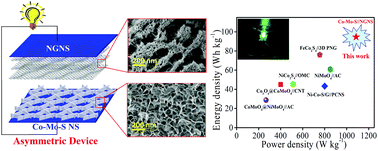High-energy asymmetric supercapacitors based on free-standing hierarchical Co–Mo–S nanosheets with enhanced cycling stability†
Abstract
Layered transition metal sulfides (TMS) are emerging as advanced materials for energy storage and conversion applications. In this work, we report a facile and cost-effective anion exchange technique to fabricate a layered, multifaceted, free standing, ultra-thin ternary cobalt molybdenum sulfide nanosheet (Co–Mo–S NS) architecture grown on a 3D porous Ni foam substrate. The unique Co–Mo layered double hydroxides are first synthesized as precursors and consequently transformed into ultra-thin Co–Mo–S NS. When employed as an electrode for supercapacitors, the Co–Mo–S NS delivered an ultra-high specific capacitance of 2343 F g−1 at a current density of 1 mA cm−2 with tremendous rate capability and extraordinary cycling performance (96.6% capacitance retention after 20 000 cycles). Furthermore, assembled Co–Mo–S/nitrogen doped graphene nanosheets (NGNS) in an asymmetric supercapacitor (ASC) device delivered an excellent energy density of 89.6 Wh kg−1, an amazing power density of 20.07 kW kg−1, and superior cycling performance (86.8% capacitance retention after 50 000 cycles). Such exceptional electrochemical performance of Co–Mo–S NS is ascribed to the good electrical contact with the 3D Ni foam, ultra-high contact area with the electrolyte, and enhanced architectural softening during the charging/discharging process. It is expected that the fabricated, unique, ultra-thin Co–Mo–S NS have great potential for future energy storage devices.



 Please wait while we load your content...
Please wait while we load your content...